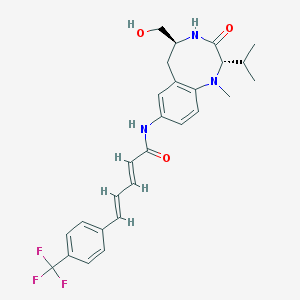| Cas No.: | 497259-23-1 |
| Chemical Name: | (2S,5S)-(E,E)-8-(5-(4-(Trifluoromethyl)phenyl)-2,4-pentadienoylamino)benzolactam |
| Synonyms: | (2S,5S)-(E,E)-8-(5-(4-(Trifluoromethyl)phenyl)-2,4-pentadienoylamino)benzolactam; PKC Activator V |
| SMILES: | CC(C)[C@H]1C(=O)N[C@@H](CC2=C(N1C)C=CC(=C2)NC(=O)/C=C/C=C/C3=CC=C(C=C3)C(F)(F)F)CO |
| Formula: | C27H30F3N3O3 |
| M.Wt: | 501.55 |
| Sotrage: | 2 years -20°C Powder, 2 weeks 4°C in DMSO, 6 months -80°C in DMSO |
| Description: | α-Amyloid Precursor Protein Modulator(TPPB) is a cell-permeable benzolactam-derived protein kinase C (PKC) activator with a Ki of 11.9 nM. |
| Target: | PKC:11.9 nM (Ki) |
| In Vivo: | TPPB is evaluated for induction of hyperplasia after topical application to the shaved backs of outbred Sencar mice and shows a modest response at 300 μg[1]. |
| In Vitro: | By use of a cell line derived from an Alzheimer’s disease patient, significant enhancement of sAPPα secretion is achieved at 1 μM concentration for TPPB (Compound 5e)[1]. TPPB has a role against Aβ25-35-induced neurotoxicity in PC12 cells. TPPB at concentration of 1 μM could antagonize Aβ25-35 induced cell damage. TPPB could increase the phosphorylation of Akt, PKC, MARCKS and MAPK, which are inhibited by Aβ25-35 treatment. TPPB inhibits the activation of caspase-3 induced by Aβ25-35[2]. |
| Cell Assay: | 24 h after plating 2×104 pheochromocytoma PC12 cells in each well of a 96 well plate, cells are incubated with TPPB at a series of concentration (0.1, 0.5, 1, 5, 10, 20 μM). Twelve to 24 h later, the original media is replaced with media containing MTT at a final concentration of 0.5 g/L for 4 h. Cell viability is evaluated with MTT assays[2]. |
| Animal Administration: | Mice: Mice are 7 weeks old at the beginning of the treatments and are in the resting phase of the hair cycle. TPPB is applied once or else are applied twice weekly for a total of four applications. Two animals are treated at each dose of compound, and 72 h after the last application, the animals are euthanized. Two portions of treated skin are removed from each animal, fixed in neutral buffered formalin, and stained with hematoxylin and eosin for histological analysis[1]. |
| References: | [1]. Kozikowski AP, et al. New amide-bearing benzolactam-based protein kinase C modulators induce enhanced secretion of the amyloid precursor protein metabolite sAPPalpha. J Med Chem. 2003 Jan 30;46(3):364-73. [2]. Yang HQ, et al. Neuroprotective effects of new protein kinase C activator TPPB against Aβ????? induced neurotoxicity in PC12 cells. Neurochem Res. 2012 Oct;37(10):2213-21. |

 To enhance service speed and avoid tariff delays, we've opened a US warehouse. All US orders ship directly from our US facility.
To enhance service speed and avoid tariff delays, we've opened a US warehouse. All US orders ship directly from our US facility.




















